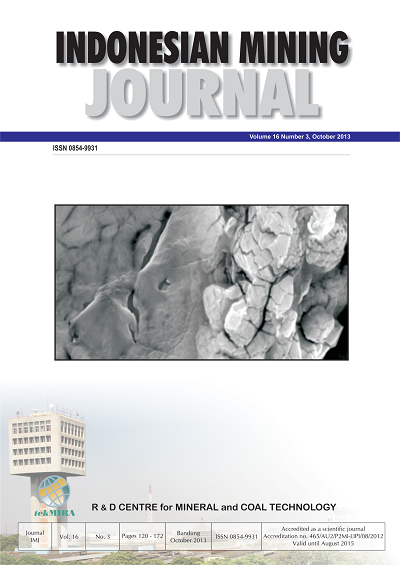EFFECT OF HYDROTHERMAL DEWATERING ON COKE ADDITIVE MAKING FROM LOW RANK COAL (LRC)
DOI:
https://doi.org/10.30556/imj.Vol16.No3.2013.379Keywords:
hydrothermal dewatering, low rank coal, corrected hydrogen and oxygen, coke additiveAbstract
This paper describes a study of the effects of hydrothermal dewatering (HTD) of Jambi, Pendopo and Wahau low rank coals, on additive characteristics. Hydrothermal upgrading and dewatering of the coals were carried out in a batch-type autoclave reactor at temperatures 350°C at a maximum pressure of 30 bar for 30 min. The dried sample resulted from hydrothermal process mixed with liquid fraction tar solvent at 250-350°C with ratio 4:6, was input in the 0,5 l autoclave to conduct hydrogenation process with variation initial hydrogen pressure of 10, 20, 30, 40, 50 bar, and reaction temperature of 400°C for 1 hour. The process of hydrothermal treatment before hydrogenation produced a higher calorific value having an average of >8000 cal/g (air dried basic, adb). Ash content and volatile matter for the coal were increased with the increasing initial hydrogen pressure. Corrected hydrogen content steadily increased after hydrothermal process and hydrogenation while the corrected oxygen decreased drastically after the hydrogenation process. Fuel ratio of Jambi, Pendopo and Wahau coals after hydrothermal process also increase reached 1.58, 1.04 and 1.77 respectively. Overall results indicate the impor- tance of introducing a hydrothermal treatment step for the improvement of the coke additive characteristics.
References
Jiang, J., Wang, Q., Wang, Y., Tong, W. and Xiao, B., 2007. GC/MS Analysis of coal tar composition produced from coal pyrolysis, Bull. Chem. Soc. Ethiop. 21(2). p. 229-240.
Maity, S.K., Ancheyta, J., Soberanis, L. and Alonso, F., 2003. Catalysts for hydroprocessing of Maya heavy crude, Applied Catalysis A: General 253. p. 125–134.
Mursito. A.T., Hirajima. T. and Sasaki. K., 2010. Up- grading and dewatering of raw tropical peat by hydrothermal treatment. Fuel 89, p. 635-641.
Mursiti, A.T., Harijima, T. and Sasaki, K., 2011. Alkaline hydrothermal de-ashing and desulfurization of low quality coal and its application to hydrogen-rich gas generation, Energy Conversion and Management 52, p.762-769.
Nagawa, H., Namba, A., Bohlmann, M. and Miura, K., 2004. Hydrothermal dewatering of brown coal and catalytic hydrothermal gasification of the organic compounds dissolving in the water using a Novel Ni/Carbon catalyst, Fuel, 83, p. 719-725.
Ningsih, Y.B., 2013. Studi proses hydrothermal dan hidrogenasi terhadap pembatubaraan buatan serta pemanfaatannya sebagai bahan baku kokas, Thesis Magister, Program Studi Rekayasa Pertam- bangan, Institut Teknologi Bandung.
Prawisudha, P., Namioka, T. and Yoshikawa, K., 2012. Coal alternative fuel production from municipal solid wastes employing hydrothermal treatment, Applied Energy 90, p. 298-304.
Sakaguchi, M., Laursen, K., Nakagawa, H. and Miura, K., 2008. Hydrothermal upgrading of Loy Yang Brown coal - Effect of upgrading condition on the characteristics of the products, Fuel Processing Technology 89, p. 391-396.
Schieke, J., 2010. Using pyrolysist tar to meet fuel specifications in coal-to-liquids plants, Foster Wheeler Business Solutions Group and Reading, United of Kingdom.
Shui, H., Li, H., Chang, H., Wang, Z., Gao, Z., Lei, Z. and Ren, S., 2011. Modification of sub-bituminous coal by steam treatment: caking and coking properties, Fuel Processing Technology 92, p. 2299-2304.
Wang, Z., Shui, H., Pei, Z. and Gao, J., 2008. Study on the hydrothermal treatment of Shenhua coal, Fuel 87, p. 527-533.
Downloads
Issue
Section
License
Indonesian Mining Journal provides immediate open access to its content on the principle that making research freely available to the public to supports a greater global exchange of knowledge.

This work is licensed under a Creative Commons Attribution-NonCommercial 4.0 International License.













